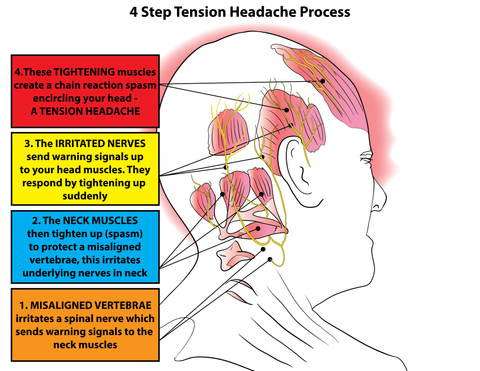Treating Tension Headaches - Trigger Point Therapy
Tension Headaches and Trigger Points - Dr. Jonathan Kuttner MD
Tension headaches usually affect both sides of the head and last from thirty minutes to several days or more
TTH are by far the most common type of chronic headache. People who experience migraines typically also have tension headaches in between their migraines. These are often referred to as transformed headaches.

Symptoms of TTH
Tension headaches usually affect both sides of the head and last from thirty minutes to several days or more.
They often have a characteristic tight-band or vice like pain with a ‘dull steady aching’ quality. Symptoms can vary in intensity from mild to moderate to severe. They may also typically affect sleep.
These headaches are NOT accompanied by the additional symptoms that traditionally distinguish migraine headaches such as light sensitivity (photophobia), and flashes and patterns in the eyes (visual scotoma).
Tension headaches are said to affect about 1.4 billion people (20.8% of the population) and are more common in women than men (estimated at 23% to 18% respectively).

Massaging the Shoulders as Part of Treating Tension Headaches - Maureen Abson
TTH and Trigger Points
Muscular problems and tension are commonly associated with TTH and trigger points within muscles may either be causative or may perpetuate TTH.
The most commonly affected muscles are Trapezius, Sternocleidomastoid, Temporalis, Masseter and Occipitofrontalis. There is also a strong association with postural issues such as the upper crossed pattern.
The pain processing part of the central nervous system is almost certainly involved in TTH as it shows up abnormal in scans.
Trigger points often add to the misery of headaches because they are associated with peripheral and central sensitization.
Long-term inputs from trigger points may lead to a vicious cycle that converts periodic headaches into chronic tension headaches.
In these cases even if the original initiating factor is eliminated, the trigger point-central sensitization cycle can perpetuate or even worsen.
Aggravating Factors
TTH's are often aggravated by stress, anxiety, depression, fatigue, noise, and glare, but they can also be associated with neck arthritis or neck disc problems.
Acute or Chronic
TTH headaches can be episodic or chronic. Episodic tension-type headaches are defined as tension-type headaches occurring fewer than 15 days a month, whereas chronic tension headaches occur 15 days or more a month for at least 6 months.
Headaches can last from minutes to days, months or even years, though a typical tension headache lasts 4–6 hours.
Seven Main Causes
The following are considered some of the main causes of TTH:
-
Sleep deprivation
- Stress: usually occurs in the afternoon after long stressful work hours
-
Uncomfortable stressful position and/or bad posture
-
Irregular meal time (hunger is reported in up to 50% of people)
-
Eyestrain
-
Tooth Clenching (bruxism)
-
Postural issues
Treatment
Numerous studies have indicated that active trigger points in neck and shoulder muscles contribute to tension-type headache, and that the pain profile of this headache may be provoked by referred pain from active TrPs in the posterior cervical, head and shoulder muscles.
The presence of active trigger points has also been associated with a higher degree of sensitization in tension-type headaches.
We treat headache sufferers daily in our clinics, and our own experience continues to confirm that trigger point therapy can have both immediate and long lasting effects for the treatment of tension type headaches and importantly can help to reduce dependency on medication.
Find a Trigger Point Professional in your area
Articles About Headaches and Trigger Points
Dry Needling for Trigger Points
Certify as a Trigger Point Therapist
NAT Online Trigger Point Courses:
This trigger point therapy blog is intended to be used for information purposes only and is not intended to be used for medical diagnosis or treatment or to substitute for a medical diagnosis and/or treatment rendered or prescribed by a physician or competent healthcare professional. This information is designed as educational material, but should not be taken as a recommendation for treatment of any particular person or patient. Always consult your physician if you think you need treatment or if you feel unwell.
About Niel Asher Education
Niel Asher Education (NAT Global Campus) is a globally recognised provider of high-quality professional learning for hands-on health and movement practitioners. Through an extensive catalogue of expert-led online courses, NAT delivers continuing education for massage therapists, supporting both newly qualified and highly experienced professionals with practical, clinically relevant training designed for real-world practice.
Beyond massage therapy, Niel Asher Education offers comprehensive continuing education for physical therapists, continuing education for athletic trainers, continuing education for chiropractors, and continuing education for rehabilitation professionals working across a wide range of clinical, sports, and wellness environments. Courses span manual therapy, movement, rehabilitation, pain management, integrative therapies, and practitioner self-care, with content presented by respected educators and clinicians from around the world.
Known for its high production values and practitioner-focused approach, Niel Asher Education emphasises clarity, practical application, and professional integrity. Its online learning model allows practitioners to study at their own pace while earning recognised certificates and maintaining ongoing professional development requirements, making continuing education accessible regardless of location or schedule.
Through partnerships with leading educational platforms and organisations worldwide, Niel Asher Education continues to expand access to trusted, high-quality continuing education for massage therapists, continuing education for physical therapists, continuing education for athletic trainers, continuing education for chiropractors, and continuing education for rehabilitation professionals, supporting lifelong learning and professional excellence across the global therapy community.

Continuing Professional Education
Looking for Massage Therapy CEUs, PT and ATC continuing education, chiropractic CE, or advanced manual therapy training? Explore our evidence-based online courses designed for hands-on professionals.



















